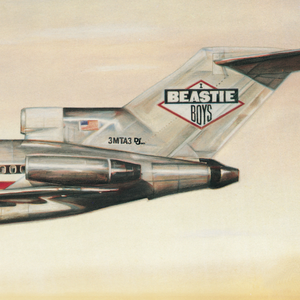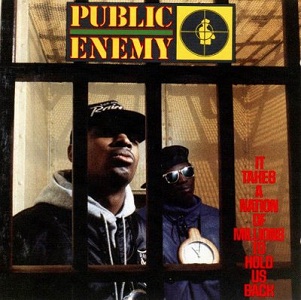
Beastie Boys were an American rap rock group from New York City, formed in 1981. The group was composed of Michael "Mike D" Diamond, Adam "MCA" Yauch, and Adam "Ad-Rock" Horovitz. Beastie Boys were formed out of members of experimental hardcore punk band the Young Aborigines in 1978, with Diamond as vocalist, Jeremy Shatan on bass guitar, John Berry on guitar, and Kate Schellenbach on drums. When Shatan left in 1981, Yauch replaced him on bass and the band changed their name to Beastie Boys. Berry left shortly thereafter and was replaced by Horovitz.

The new school of hip hop was a movement in hip hop music, beginning in 1983–84 with the early records of Run–D.M.C. and LL Cool J. Like the preceding hip hop, it came predominantly from New York City. The new school was characterized by drum machine led minimalism, often tinged with elements of rock. It comprised rapping taunts, boasts, and socio-political commentary delivered in an aggressive, self-assertive style. In song and image its artists projected a tough, cool, street b-boy attitude. These elements contrasted sharply with funk and disco, novelty hits, live bands, synthesizers and party rhymes of artists prevalent in the early 1980s, thus rendering them old school. New school artists crafted shorter songs more amenable to airplay, and more cohesive LPs than their old school counterparts. By 1986 their releases began to establish hip hop as a fixture of the mainstream.

Licensed to Ill is the debut studio album by American rap rock group Beastie Boys. It was released on November 15, 1986, by Def Jam and Columbia Records, and became the first rap LP to top the Billboard album chart. It is one of Columbia Records' fastest-selling debut records to date and was certified Diamond by the Recording Industry Association of America in 2015 for shipping over ten million copies in the United States.

Paul's Boutique is the second studio album by American hip hop group Beastie Boys, released on July 25, 1989, by Capitol Records. Produced by the Dust Brothers, the album is composed almost entirely from samples, and was recorded over two years at Matt Dike's apartment and the Record Plant in Los Angeles.

Check Your Head is the third studio album by American rap rock group Beastie Boys, released by Capitol Records on April 21, 1992. Three years elapsed between the releases of the band's second studio album Paul's Boutique and Check Your Head, which was recorded at the G-Son Studios in Atwater Village in 1991 under the guidance of producer Mario Caldato Jr., the group's third producer in as many albums. Less sample-heavy than their previous records, the album features instrumental contributions from all three members: Adam Horovitz on guitar, Adam Yauch on bass guitar, and Mike Diamond on drums.

Hello Nasty is the fifth studio album by American rap rock group Beastie Boys. It was released on July 14, 1998, by Capitol Records and sold 681,000 copies in its first week, debuting at number 1 on the Billboard 200 album sales chart. The album won two awards at the 1999 Grammys, in the categories of Best Alternative Music Album and Best Rap Performance by a Duo or Group for "Intergalactic". In the Beastie Boys Book, Ad-Rock said he felt that Hello Nasty was their "best record".

Ill Communication is the fourth studio album by American hip-hop group Beastie Boys, released by Grand Royal Records on May 31, 1994. Co-produced by Beastie Boys and Mario Caldato, Jr., it is among the band's most varied releases, drawing from hip hop, punk rock, jazz, and funk, and continues their trend away from sampling and towards live instruments, which began with their previous release, Check Your Head (1992). The album features musical contributions from Money Mark, Eric Bobo and Amery "AWOL" Smith, and vocal contributions from Q-Tip and Biz Markie. Beastie Boys were influenced by Miles Davis's jazz rock albums On the Corner (1972) and Agharta (1975) while recording Ill Communication.
Wendell Timothy Fite, also known as DJ Hurricane is an American hip hop DJ, producer and rapper. He is best known for his work with the Beastie Boys. He was a member of the groups Solo Sounds and The Afros and recorded three solo albums, featuring many well-known artists such as Xzibit, Public Enemy, Kool G Rap, Black Thought, Papoose and Talib Kweli.

Critical Beatdown is the debut studio album by American hip hop group Ultramagnetic MCs, released on October 4, 1988, by Next Plateau Records. Production for the album was handled primarily by the group's rapper and producer Ced-Gee, who employed an E-mu SP-1200 sampler as the album's main instrument. Music journalists have noted the album for its innovative production, funk-based samples, self-assertive themes, ingenious lyricism, and complex rhyme patterns by Ced-Gee and fellow rapper Kool Keith.

Mario Caldato Jr., also known as Mario C., is a Brazilian-born record producer and studio engineer best known for his work with Beastie Boys and Jack Johnson in the US, and with Marcelo D2 and Seu Jorge in Brazil. He is the winner of three Latin Grammys along with several nominations and multi-platinum and gold records to his credit.

"Shadrach" is a song by rap trio Beastie Boys from their album Paul's Boutique. Released on October 30, 1989, it was the second and final single released from the album.
The Beastles is the name of a fictional band created by dj BC. The music is a mashup of music from the Beatles and the Beastie Boys.

F-Punk is a studio album by Mick Jones' post-Clash band Big Audio Dynamite, released in 1995. It was the first album to be released under the name of Big Audio Dynamite since 1989's Megatop Phoenix. The title is a pun on the funk group P-Funk, and is supposed to imply "Fuck punk." The album cover lettering takes influence from London Calling, one of Mick Jones' albums with The Clash, which in turn was a copy of Elvis Presley's debut album.

"Rock Box" is a song by the American hip hop group Run-DMC. The song was produced by Larry Smith and Russell Simmons and released by Profile Records in March 1984. Following the popularity of their previous two singles "Hard Times" (1983) and "It's Like That" (1983), Profile Records head suggested to the producers and group that they should attempt to record an album as they already had four songs ready, and releasing a few more would not hurt them. Despite speculating low sales from the label and the group not feeling that hip hop was a genre appropriate for a full-length album, they were given an advance to start recording. This led to Run-DMC members Joseph "Run" Simmons and Darryl "DMC" McDaniels going through their rhyme book to develop new songs, one of which would become "Rock Box".
Birth Through Knowledge were a Canadian rap rock band best known for their 1998 single "Peppyrock." Core members of the group were DJs Stone Groove and Lo-Ki.

It Takes a Nation of Millions to Hold Us Back is the second studio album by American hip hop group Public Enemy, released on June 28, 1988, by Def Jam Recordings and Columbia Records. It was recorded from 1987 to 1988 in sessions at Chung King Studios, Greene St. Recording, and Sabella Studios in New York.

"Sucker M.C.'s" is a song by American hip hop group Run-D.M.C. It was first released in 1983 as B-side to "It's Like That". The two-sided release marked the start of Run-D.M.C.'s career as their first single, and it is widely regarded as ushering in a new school of hip hop artists with a street image and an abrasive, minimalist sound that marked them out from their predecessors. Both tracks were collected on the trio's self-titled debut album in 1984. WBAU was the first station to play the two songs.

Run-DMC was an American hip hop group from Hollis, Queens, New York City, founded in 1983 by Joseph Simmons, Darryl McDaniels, and Jason Mizell. Run-DMC is regarded as one of the most influential acts in the history of hip hop culture and one of the most famous hip hop acts of the 1980s. Along with Beastie Boys, LL Cool J and Public Enemy, the group pioneered new school hip hop music. The group was among the first to highlight the importance of the MC and DJ relationship.
"That's The Joint" is a song by rap group Funky 4 + 1 released as their second single.














